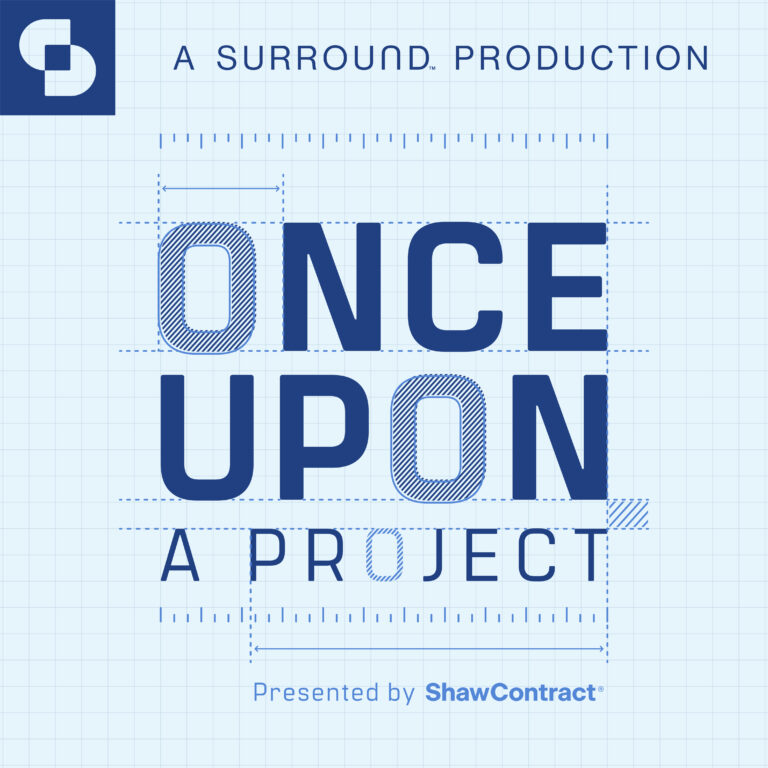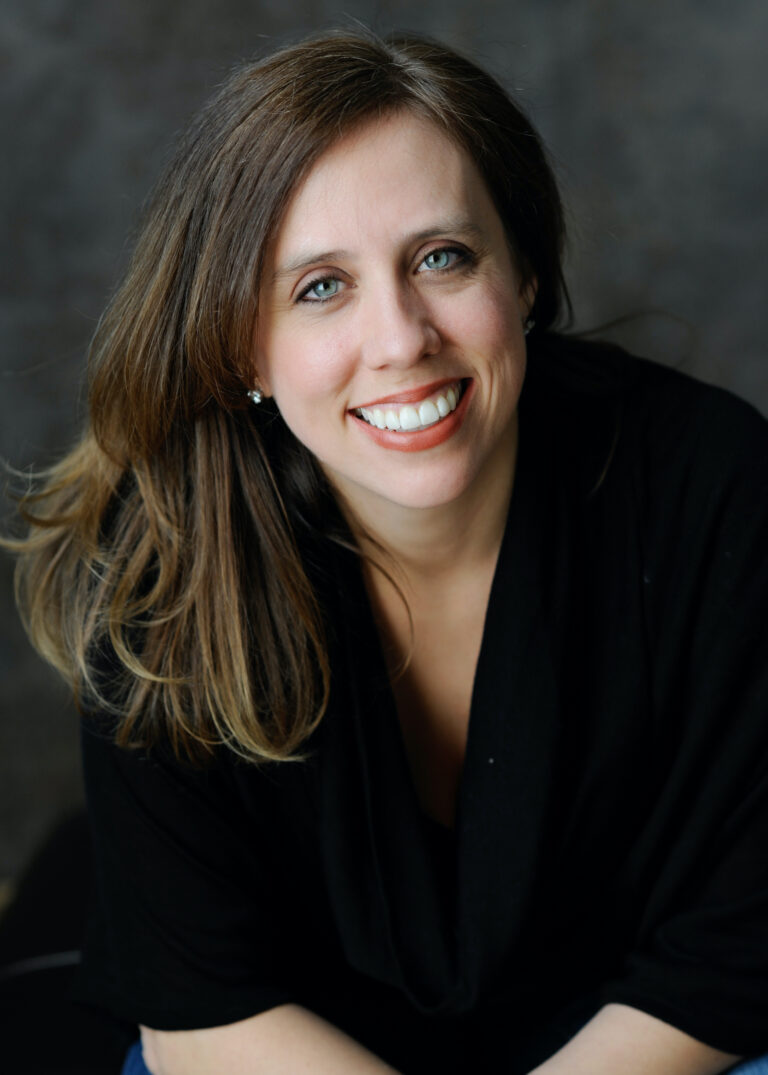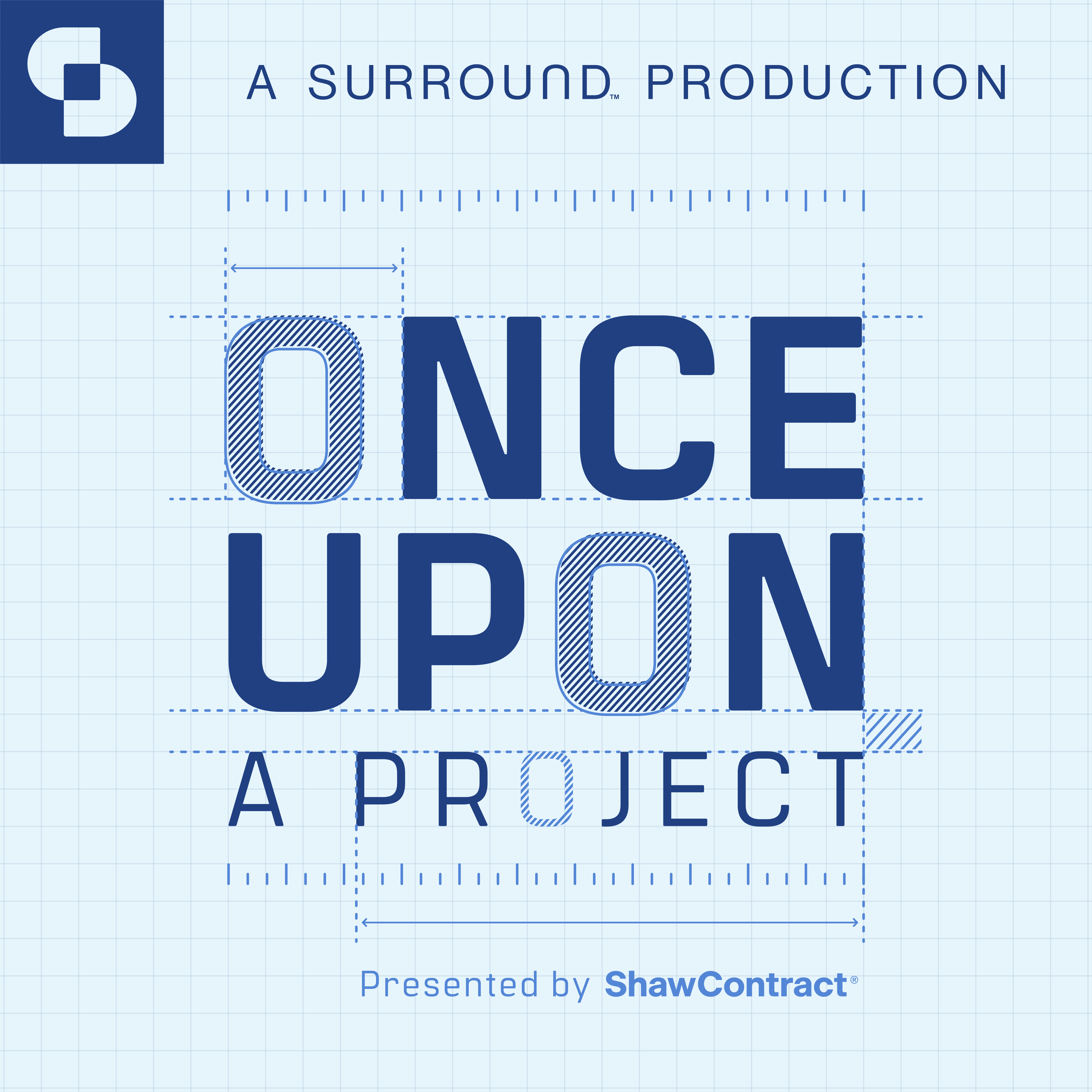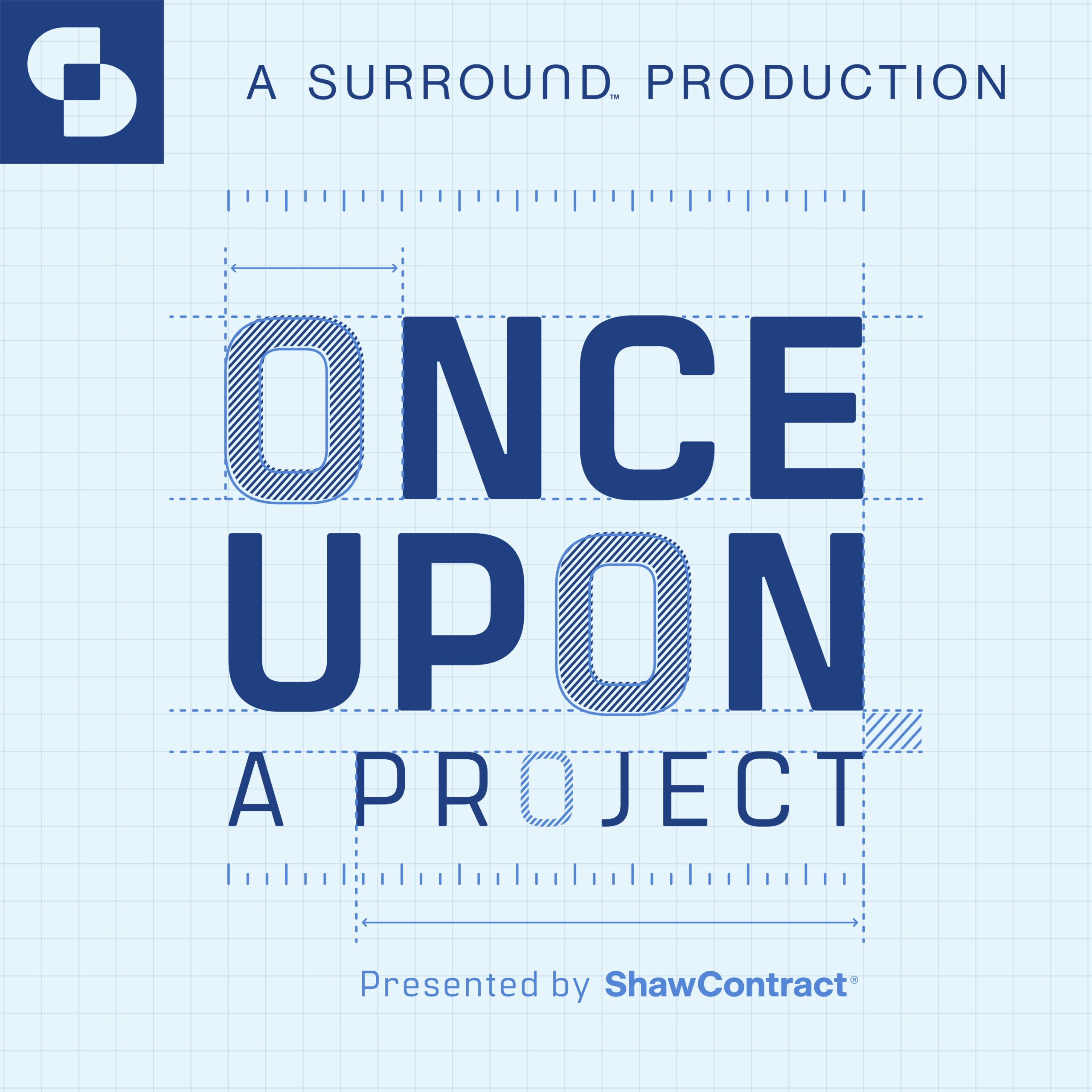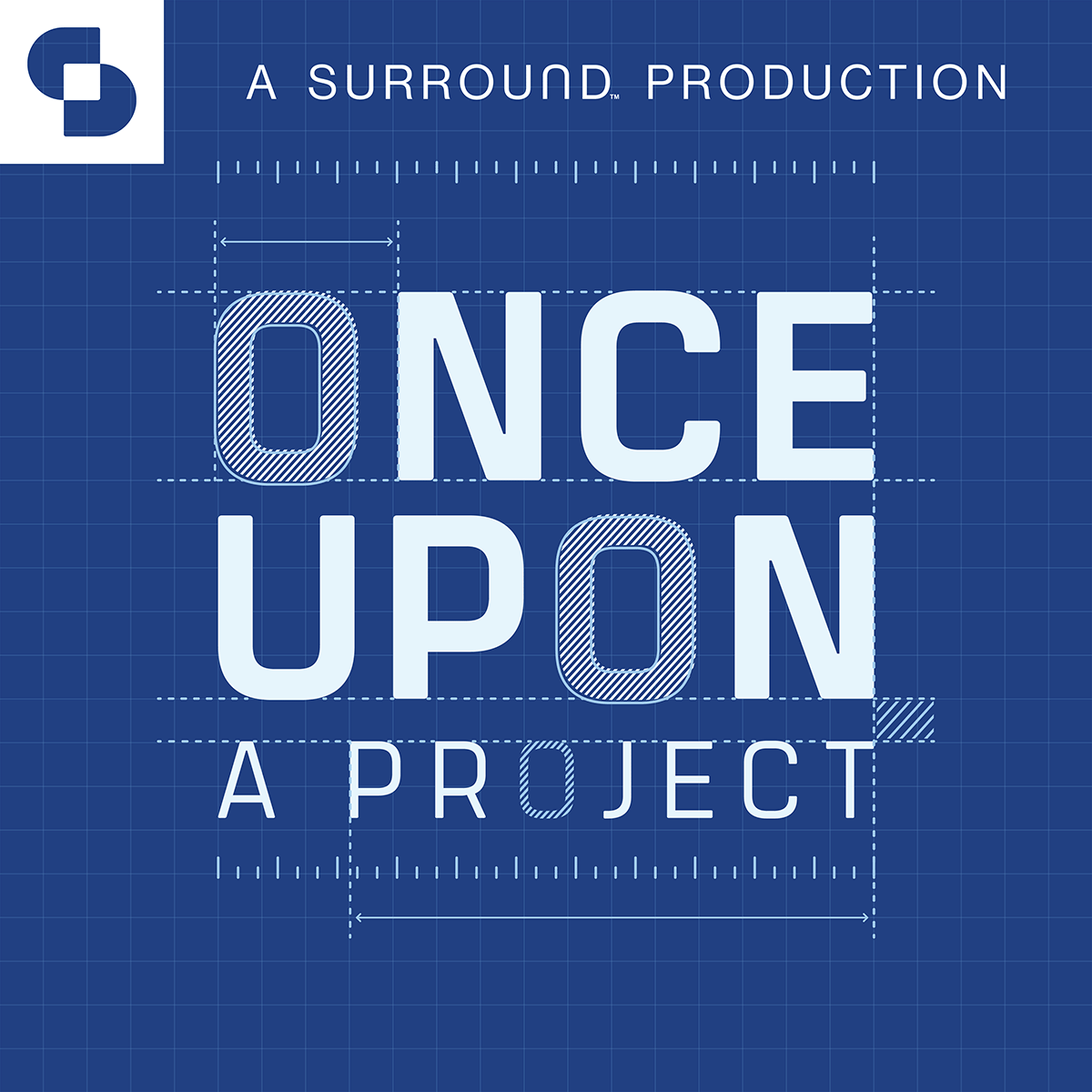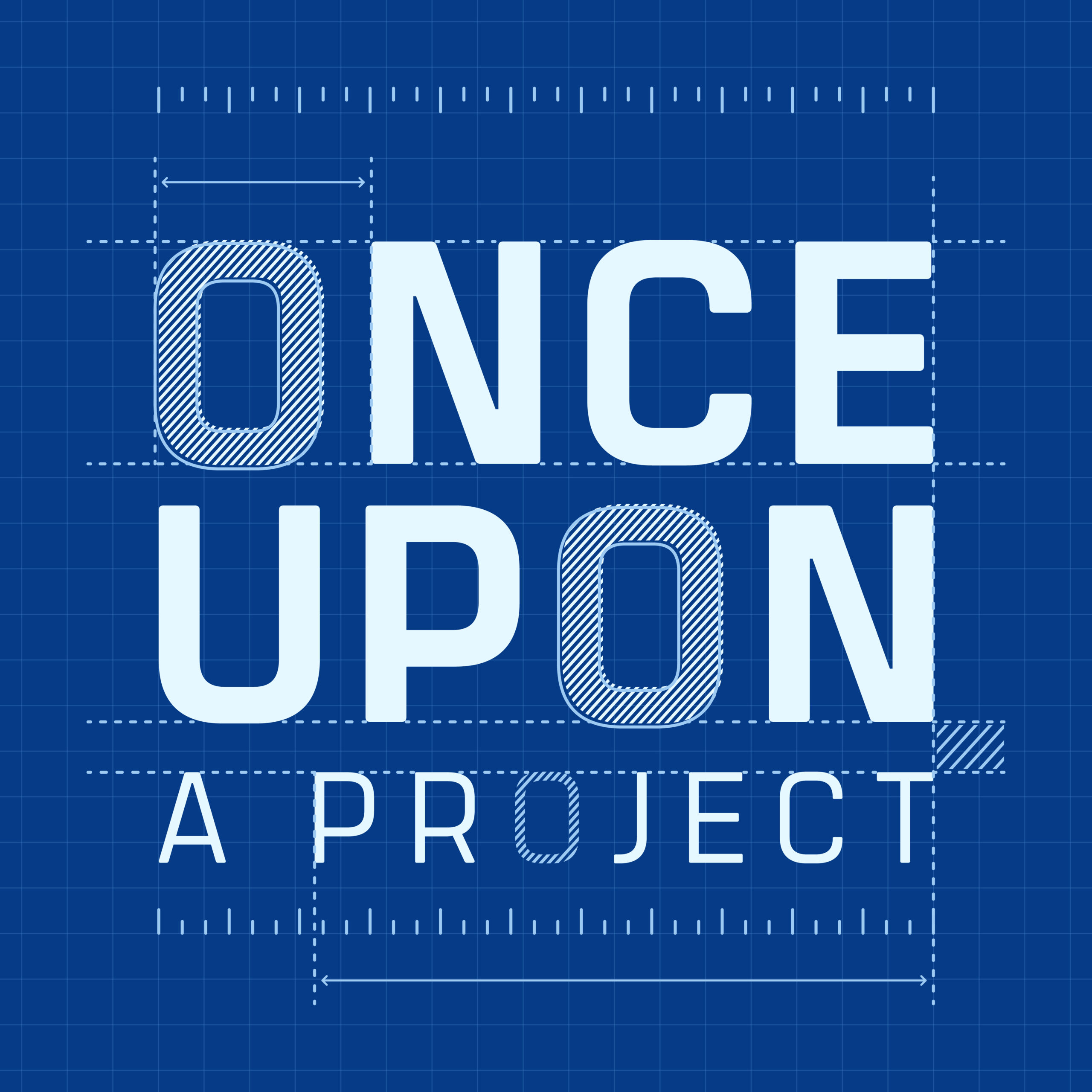Betsy Vohs of Studio BV cultivated a unique relationship with client Evereve that evolved into designing not only their office but the co-CEO’s home and then redefining what their retail brand looked like post-pandemic. Listen in as Vohs discusses how good design can empower everyone that it touches—from her team to her clients and her client’s clients—across retail, workplace, and not-for-profit organizations.
Explore SANDOW Design Group Brands
AJ Paron: [00:00:00] As interior designers, we’re accustomed to celebrating the end of the project. All the final touches in place, installation is complete, and hopefully we have an ecstatic, happy client. But what about the process— the complex journey and people behind the polished and finessed final result?
Welcome to Once Upon a Project, a new show [00:00:30] from the SURROUND Podcast Network by SANDOW.
I’m your host AJ Parron, Design Futurist and Executive Vice President at SANDOW Design Group, delivering design brands you know and love, like Interior Design magazine, Metropolis magazine, Luxe, ThinkLab, and more.
For today’s story, we’re going to look at three completely different projects that are woven together by an evolution of goals from the client and the award-winning [00:01:00] designer Betsy Vohs.
Betsy and her creative team at Studio BV show us how small firms can be mighty, even in the case of creating amazing projects that showcase the impact of design.
Betsy Vohs: It’s been six and a half years since I started the business. It is really a privilege to get to run a firm. I do think, every day, I wake up and think I’m the luckiest person in the world, and I don’t take that for granted—never once. [00:01:30]
I feel like if you think about this as a gift, or an opportunity, or privilege, what do you want to do with it?
AJ Paron: Let’s start our journey to hear the challenges of growth, the reimagining of retail, and how those projects can fuel design for good in their community and beyond.
Betsy Vohs: I am Betsy Vohs, the CEO and founder of Studio BV in Minneapolis, Minnesota. We are a group of designers that work in multi-disciplinary avenues. We love to solve problems [00:02:00] in a lot of different typologies and scales, and so we really don’t think we’re experts. We think we are just creative problem solvers.
I’ve been a designer for over 20 years now, so that makes me old.
AJ Paron: Betsy’s passion for design and helping people are anything but old.
Let’s hear her talk about her journey with a client that started with their office, transformed to their home, and then finished to reimagining retail—post-pandemic—across their brand.
Betsy Vohs: I’d love to tell the story of our relationship with Evereve. [00:02:30]
Evereve is a boutique women’s clothing brand. They’re founder-led company that’s based in Minneapolis. They have about 130 stores around the country. They carry lots of different brands, but they also carry about 30% of their own design products.
My relationship with them goes back probably 10 years, doing some store design work in about 2013-14, and then in 2017 they asked me to design their first real [00:03:00] office.
They were living in a very charming, sort of, retail mixed-use small building in Edina, Minnesota, which was lovely, but did not really serve their needs. They had a lot of people packed into a very tiny space, and it wasn’t really office space. It just really didn’t function very well for them.
But the charm of it, the culture of it, it was close to where everyone lived, it was very walkable to retail. They hung on to it for a very long time until they were literally bursting at the seams.
They had like 80 people [00:03:30] working for them, and no one could come and really connect because the space didn’t work really well. It wasn’t set up for that.
So, moving into an office space was, I think, for them transformative in lots of ways. It really put them into a platform where they could do their best work, which I think that’s what office design is striving to do for every organization—is to create a landscape in which they can do the best work possible and to really drive their business to a new place.
[00:04:00] For them, the leadership team, it was scary because, you know, quirky, smaller residential type spaces were what they knew. And going into an office building and a huge, you know, parking lot, and this all sorts of shifts that they were worried that would really kind of kill their culture and kill this sort of innovative spirit that really makes their business special.
Listening to that was really important, and we spent a lot of time with them, and we worked on how do we translate what happens in the store environment to the office space. [00:04:30]
They’re trying to do things with clients that are very specific and interesting, and so we wanted them to start to think about the office design the same way. And that really unlocked that potential for them of what office really could be.
It’s been amazing. Coming into that space has been very successful for them. They’ve grown, they’ve used it. It’s just been a tool that they couldn’t even imagine what it would be like before they got there, which is as a designer, the best you could ever ask for, right? Is that [00:05:00] whatever tools you gave a client through the design process has really changed them for the better and made them grow. So that was very rewarding and very joyful.
AJ Paron: Betsy’s success on completing a large, complex project earned her client’s trust. And for her next challenge that trust brought her into a much more intimate project, and then a redefinition of a brand.
Betsy Vohs: That relationship then really grew. Their organization was growing, so [00:05:30] they’d asked me to work on their home, which was a really fun project.
The co-CEOs are a married couple—husband and wife. They’re wonderful people who have a very clear vision of who they are, and they love design. And so, any designer wants to work with clients that love design because design’s joyous and wonderful, and my firm got to do that wonderful project with their house. And then they came and started to think about store design in a new way.
You know, this was 2019, so this is pre-pandemic. They’ve asked us to think about what could the stores really become [00:06:00] in the future. How could that really change?
It’s a unique project because Megan, the founder—and she’s really the leader, I think, spiritually, too, of the business—she started this business 15 years ago, and as a business leader, as a woman, she’s evolved. And she, you know, has kids in college; she’s no longer a young mother. She’s just kind of transformed. And I think she’s really the ambassador for the voice of the customer.
I think she wanted to tackle where are we going to go next? [00:06:30] Because our design is sort of 10 years ago in terms of where she was—and in terms of maybe where the customer was—and how can we use design as an opportunity to open the door and maybe widened the brand and really acknowledge an audience that’s maybe not being acknowledged in the current design.
We spent a lot of time with Megan and thinking about what her vision could be. That was a lovely, deep dive experience that lasted about 3 months. We presented [00:07:00] end of March two years ago, 2020. And then, of course, 2020 happens.
It was catastrophic. They couldn’t even have stores open. And in retail, stores not open is “We’re dead. Right?” There’s no money because no one’s buying.
Megan and Mike as the founders and leaders—they’re such good leaders—and I do think working with clients that you get to know, and you get to see how they lead and how they really guide things and handle adversity is really such a gift to me, and I never waste those opportunities.
So, they really [00:07:30] started to think about how are we going to be different? What are we going to do? As business, you know, ramped up online, but also ramped up sort of that curated experience of their customers in a non-physical way. They also started to think about how they communicate it to clients. What does it mean?
They started using that office space as a studio. They started doing a ton of Instagram Stories, Facebook Live stuff, and it was interactive because the Evereve brand is such an experience-based brand that without that personal connection, it doesn’t [00:08:00] really have the same affiliation for their clients and their customers.
So, they really rethought all of that, and it became this way to connect with them as people. They were more vulnerable. They were out there, and it just really changed, I think, how loyal their customer is, but also how they worked with them and talk to them.
And they did well in the pandemic. Retail got hit hard. They didn’t. And they kind of pivoted their business to be so much more reactive and [00:08:30] digitized and connecting to people in ways that they didn’t do before.
And then they said, “Let’s talk about stores, Betsy.”
This was end of 2020. I was like, “Okay.” We were in pre-vaccine still, so they’re like let’s start talking about stores again. And I was like, “Okay. All right. Let’s start talking about stores because lots has changed in the almost year since we pick this up, right.” A lot has changed. And I think as designers, we design for people, right? And we have to hear [00:09:00] and listen and try to understand the people.
They changed, and they were so open to take risks and to really rethink this box that is retail space, and what they’re doing and where they’re going and what parts of the country they’re in. And they’re like, we’re going to California. We’re going to very high-end stores which, I’ll be honest, they were in lots of states around the country, but they weren’t next to Tiffany’s. And they said we’re going for it, and we need to really, really rethink what this is about.
[00:09:30] Which for me was like, dream come true, because now gloves are off. There’s no “let’s just nibble at the edges.” No, it was a total what would it be if it could be something new, and that was gold.
AJ Paron: We’ve heard this all throughout the pandemic. This pause—this massive global shift—it allowed the opportunity for clients and designers to reimagine the new. [00:10:00] What if you didn’t just put Band-Aids all over it? What if you could work on a totally new concept that could catapult you into the future, where you could thrive and not just get by?
Betsy Vohs: We went back to sort of zero, and said what could it be? If it never was before, what could it be? And it looks radically different.
It is, I would, say more sophisticated. It’s more art focused. Megan loves arts, and I love art—that is a true addiction that I have—and it was [00:10:30] how do we get an authentic art story in each store that’s unique? How do we think about what accessories are? How do we think about the furnishings? The rugs? These are not things that people in retail, who are trying to sell jeans and sweaters, are ever talking—they don’t care.
Like most CEOs are like, we need to sell more stuff. Let’s pack it in. Right? Like, it’s not about what art could we get here, and what can we do with custom lighting? And wouldn’t that be great if we employed these makers and this person? I mean, that was conversations [00:11:00] we were never going to have pre-pandemic. That wasn’t in their mind, and it wasn’t even kind of a value proposition for them. And now it was like everything’s on the table in a way that is so rich and so exciting.
There was a lot of pink, very highly feminized coloration in their previous store. There’s none of that now. It’s-it’s navy blue and wood, and black and white. It’s high contrast. It’s heavy material. We use a lot of soft geometry. There was no geometry. [00:11:30] And just thinking about building in things and customizing how we’re shaping space, it just costs more, but it has a bigger impact. And we were allowed to do that.
Everything about it—custom textiles for the drapery, for the fitting rooms, and what that would feel like, you know. Instead of shutting a door, do you, you know, take a really beautiful drapery and move that? And is that softer? Do you feel a little bit cozier in that dressing room because of that experience?
I remember talking about the dressing rooms with Mike and Megan, the two co-CEOs, [00:12:00] and we were talking about the accessories on there, and Mike goes, “They need to put their coffee down. Where’s the coffee?” Because everybody knows you’re shopping now with a drink and a bag. But the thing about the coffee is you can put your bag on the floor, but no one wants to ever put their drink on the floor.
Just the little things because behavior is behavior. You’re never going to take the Starbucks out of that experience, so let’s make it more successful. Let’s just kind of take those moments and make room for them and make space for them.
I mean, we went down to every little detail. [00:12:30] And it was all important and valued in a way that I don’t think was possible before the pandemic.
It’s fresh. It doesn’t take itself too seriously, but it’s elevated and it’s beautiful. And I think that that idea of inclusion and accessibility and beauty and openness is balanced with this refinement and this, I would say, more elegant and more sophisticated palette of materials and experiences.
AJ Paron: For most people, when you think about fashion and retail, [00:13:00] you think about beautifully designed, trendsetting stores that only the rich and famous are truly accepted or could afford. There is a negative psychological trickle-down effect to standard retail experiences.
When I walk into a store, do I feel like I should be there? Am I being judged on how I look, how rich I am, how skinny I am? Do I represent the brand?
When Betsy is talking about inclusion and accessibility this is the problem they were trying to solve [00:13:30] for.
Betsy Vohs: And that’s what we did.
I think fashion should be fun. It should be about being your best, and I think that that’s what as designers of environments we have to lay the landscape for that. We have to want to welcome people in like, “Come on in.” It has to feel warm and interesting and inviting, and it should feel like you can be there. Your daughter should want to be there and feel like, “Hey, this is for me, too. And I like being here.”
You know when you have a great shopping day, and you know when you have a bad shopping day. [00:14:00] And I think that design sometimes can play a role in that. We want things to be simple enough where people feel like they can navigate it. I do think anyone that comes into a store, whether you’re, you know, have mobility issues, if you have sight issues, we want things to be accessible and clear.
And one of the big things that we did was to sort of anchor moments visually in the store where you could sort of see things. We made the dressing room area, we did this like sort of soft arch geometry, but we made it navy in every single application. We wanted it to be an anchor backdrop. [00:14:30] We also created a lot of space around that area. So, if you’re shopping with a friend, if you’re shopping with someone who has mobility problems, they don’t feel like they can’t get to it.
It’s unlike another brand where it’s you and the clothes. It’s you, the clothes, and then your stylist. So, we physically need more space for that to happen.
They also want to have a different experience with their customer in the store, so that gives us opportunity. They want to do, when we started designing these, what if we did Facebook Lives there? [00:15:00] What if we did author events? Megan is a voracious reader. She reads so much, and she loves writers, and she loves to talk about it. So, why can’t this be a place of gathering?
When you think about those activities—you think about Facebook Live, like an ambassador event, a photo shoot, a book launch—now we need a lot more space, and we need things to be a little bit different. So, that retail space is asking more of the architecture than it ever would if it was just a retail space.
I think there was also [00:15:30] a big shift. I think pre-pandemic, every inch of real estate had a dollar value associated with it in a way that is different now because accessibility, having events, connecting with people in that space, in the brand— not virtually—it’s physically in that space, has an intangible value, and it has a space requirement that’s going to cost money, but it has such a transformative value to their brand that you can’t quantify.
And, I think, pre-pandemic I don’t know [00:16:00] if any retail owner would have got there, but with strong leadership from Megan and Mike, they understand that value and now they’re willing to pay for it.
The stores are way bigger, way bigger, and it’s because of all that. And that is awesome because that then makes have a different connection to their customer and into the community that they couldn’t have had before. And that is architecture; that is designed. That is-that is us creating a landscape for them to do the best work they can. [00:16:30]
That was absolutely wonderful as a designer, but it was also wonderful for their team because this was like a new chapter.
You want to be there. It’s about being together. It’s about having connections with people that aren’t digitized, and that are more meaningful, and that’s just so valued.
Never in your life do you get the chance to take the same subject matter, and then show the impact of design because [00:17:00] that’s the only thing that changed.
We went into stores in the same location and redid it, and then the sales are through the roof and the activities are through the roof. You never get that chance, I don’t think, to really prove is design the thing that’s changing because they didn’t all of a sudden sell different things or do something different. It was literally the scene changed. And that scene, in the urban sense—from the exterior design that we’re doing to the interior design—has transformed and been such an amazing moment [00:17:30] for them as a business, but also for me to see the impact of design. It’s just so clear. And I don’t know if we’ll ever get that again—that such clarity around the impact of design—but it has really changed everything.
AJ Paron: For many design companies, there is a goal on growth—how to expand, gain bigger and better projects that will put them on the map. But for Betsy’s team, their ambitions are a bit different than that.
Betsy Vohs: I have always loved design, and I don’t think I’ve ever [00:18:00] loved it more than I do now. Because I see how important it is for people to be in a place that has a meaning for them, just in general. Whether it’s this revolution of home renovation, because people finally realized, “Oh, my house doesn’t work for me” is-is a good thing.
Whether it’s your office, the hotel, the Airbnb, whatever-whatever it is, I do think people just I think they’re more alive and they’re more intentional and they’re thinking about it. And I think I am, too.
I would say I prioritize things differently. [00:18:30] I really feel like I hope I have a clear vision for my business. I think I have a stronger one now than before the pandemic. I want to work with clients who want design to be the story and nothing else anymore.
I think we know who we are. We’re not a big firm. We never will be. I think we are a firm who loves design work, and we love the projects that we work on, and the diversity we have. And we really want to be with clients who want to make design the forefront of their project and see something [00:19:00] transformed.
I feel like if you think about this as a gift or an opportunity or privilege, what do you want to do with it? If you can do anything, what would you do? And I try to ask myself that question because I feel like I have a little bit of agency to do that, right? Because we have really smart people, who have great brains, and who want to give back. So, I think being in the community is really important.
AJ Paron: Most designers want to feel [00:19:30] they are making a difference in the world. That their design has impact on people, communities, and the planet that is positive. But let’s face it, interior design has been historically known to be a service exclusive for the wealthy.
It’s only been the past 75 years where there’s been a movement for good design for all, no matter the social economic status.
Many feel good design is a basic human right; however, it hasn’t been that easy [00:20:00] to give access to more diverse populations, and we have a long ways to go.
Betsy Vohs: I wanted to give back in new ways. I’m on boards, but lots of people are on boards. You know, you donate money, lots of people do that. How can we use this design practice? Because that’s really the talent that we have. That’s what we have to offer the world.
How do we do this in new ways for people that don’t think that design is a possibility for them? They either don’t think that they should spend money on it because they’re a not-for-profit. They don’t think they’re worthy of it—and I have sat in meetings [00:20:30] where people say that—and it’s heartbreaking. Or they don’t have access. So, how do we become accessible, affordable, and present to them?
I have a practice called Design Forward where we’re doing pro-bono work, and that is great because, you know, the arc of a design and architecture project comes in lots of different forms, but you have to show up at the right time in the timeline to really make that effective.
And so, through the community and people [00:21:00] that we know, we have been connected to wonderful projects and gotten to work on just the most amazing projects for us. I mean, it’s the work I’m most proud of. It’s the funnest projects.
During the pandemic, we opened the model to entrepreneurs who were affected by social unrest. So, you didn’t have to be a not-for-profit, and we did 2 retail spaces for restaurants for people that got their businesses just hammered.
It’s retail. It’s a lot of office, but we are even doing our first RV. We’re working with Dress for Success, and we’re renovating an RV. [00:21:30]
Think about an organization that was place-based. You went there. You went there to try and clothes. It was sort of a physical spot in the Twin Cities where you went to do that.
In the pandemic, that wasn’t possible. So, they really shed their real estate, and now have this idea that really hasn’t been tried. It was tried in, like, the nineties in a different location, but really to do like a beautiful, high design RV that could go all over the state and meet women where they’re at. And not only for clothing, but for coaching and resume work, [00:22:00] and just be like a beacon of hope and empowerment for women. That is amazing.
So, I’m all in on that; we’re actually presenting the design today.
They called me ‘cause I knew someone on their board, and I said, “Absolutely. I’m in. Are you kidding me? When am I ever going to see that opportunity again?” So, fun stuff like that.
And my team, we’re also excited. Who wouldn’t want to work on that? That is just a once in a lifetime opportunity. And again, just for an organization that’s in the pandemic rethought how they meet people, how they do service, what they’re doing with people, and how [00:22:30] this RV becomes this sort of physical thing that can be present in communities that they could never be before, because they were in one physical location.
But I do think there’s this—don’t know why—but there’s a culture in not-for-profits that really is every dollar has to go to the grantee or to the cause, right? If we spend any money on our space or for us that’s sort of misguided. They think that if you’re in not-for-profit [00:23:00] service work, you’re not worthy of good space.
And I know that that’s not true. It’s completely not true. I would say it’s been transformational in so many different ways.
I can talk about Tubman. Tubman is the largest domestic violence organization in Minnesota. So, it does legal work. It does a lot of therapy. It has housing. It does a ton of stuff. Social work. So, they’re basically a one-stop resource for domestic violence.
They came to us with an opportunity. They were selling a building, [00:23:30] and they thought maybe we could use some of this money to renovate. They had had a building that was really a space where all their therapy and legal work happens in Minneapolis. It was built in the eighties and hadn’t been touched since. It just wasn’t really functional. It was very drab. It—I don’t know. Just not a lot of positive things. It was a 30-year-old building.
And they had some money, and I thought this is the opportunity. So, we started this pre-pandemic and finished during the pandemic, but it has been amazing for them.
You walked into that space, and the people that work there [00:24:00] are therapists working on the hardest things, and they had no access to daylight. Their furniture was, I mean, falling apart. They had rooms that were like, you know, six foot by eight. The conditions were unacceptable is the best thing I can tell you.
They couldn’t believe that we would want to change that because that was where they worked, and that was what’s important, and it’s not important to sort of make that better.
AJ Paron: You would think people working in a non-profit would be thrilled and thankful that they’re getting a nice place to work. [00:24:30] But as you hear from Betsy, the philosophies of where to spend the organization’s money has a lot of psychological baggage designers need to deal with.
Change is hard enough for employees, but not feeling you are worthy of that needed change is a whole other challenge.
Betsy Vohs: And I’m like but how could it not be? How could it, how could you give the best work to those women and people who are seeking your help, if you are in an environment that doesn’t empower you? It makes no sense. [00:25:00] And so, we had to really flip the thinking.
We often have to start with that. You deserve it; so that’s just the level set.
You need this. If you’re in a space that empowers you and makes you happy, lifts you up, is healthier, has daylight, has better materials, you’re better at your job. And the people that come here feel more empowered, feel that they’re worthy, feel like they can do it. It’s a two-way thing. So, this notion of it’s all about the programs is important, but it really isn’t. [00:25:30] Because that physical experience changes it. If you are coming in for therapy, that is a hard thing to do at any point in your life, let alone, if you’re getting out of a domestic violence situation. To be in a space that you want to go to—that makes you feel good, that makes you feel like there’s hope, and there’s a way forward—that’s what we’re trying to do. And they deserve it—the clients—and so do you.
So, we really need to educate, sometimes our clients—our pro-bono clients—[00:26:00] that’s what we want to do. We want to make this for you. And in turn, you will do the work that you do even better.
And every time we do it, it changes. They just can’t believe it. And it’s just this radical shift of who they are and who they can recruit. In a land of, you know, limited talent, I think in the whole country—especially in the upper Midwest—how do you get great talent to be in an organization? You know, how do you do this work that’s very hard?
If you had a work environment that was healthy and joyous, and telling stories, that’s going to go [00:26:30] a long way to help recruit and maintain the talent that you have, which is how you deliver services. So, we do a lot of work around that because if we talk differently about it, people can start to make better decisions. They can tell us more about how we can fix it. I do think if they don’t believe they’re worthy of it, they’re never going to really be honest with what we can do to, as a designer, to fix what’s not working, right? And so that has been so fun and inspirational for me, too.
I mean, I’m here selfishly because I want to learn, too. I mean, I’m on a journey as-as well, so whatever we can do to [00:27:00] bring someone to a new place, we want to be part of that. And then hopefully we’re evolving as well.
I have said I don’t know how I figured out this way to sort of be a boutique higher end design firm yet do it for free for some people. That’s a juggling act that’s-that’s somewhat masterful because I think a lot of our clients know that they’re part of that story and it’s important to them. And I will say we’ve been fortunate to get our pro-bono work published and visible, and I do think good design doesn’t have a price tag. [00:27:30]
You can be a good designer with paint and nothing; and you can be a good designer for an unlimited budget. Design is about ideas. It’s not about materials. But I think there is this agreement, and I think an understanding, that our process is the same, our outcomes are somewhat similar, but it’s important that we’re giving back in this way, and it’s really meaningful. It’s about 15% of my practice is that. Is that.
We’re 15 people too. Staying this small is nice for me because we all have access to it. It’s an important [00:28:00] cultural piece of my firm. I think everyone is proud of that work, and it is really great, but I do think if my small firm can do it, what could a big firm do? Imagine that.
It’s really about thinking, you know, if-if you can do whatever you want, what would you be doing? And I asked myself that question pretty early on in this business, and that was my answer. It was like giving it to people who need it most.
I mean, that’s kind of why I started my firm. I was like, “If I don’t start a firm like this, who’s going to?” No one. So, you just [00:28:30] gotta do it.
AJ Paron: There are a few things that we can learn from Betsy, and how she engages her firm and their design work.
First, bigger isn’t always better. Many young designers starting in their career look at the large firms and dream of the day they can say that they work for that prestigious firm. They look at it as the mark of their success. But past that, having purposeful work can fuel you, and fulfil you, in a way you might never could imagine.
Whether that’s a large firm [00:29:00] or a small firm, it’s about your contribution to the work in the impact of that design. And truly, for a designer, that’s why you get up in the morning.
To hear more stories about the design process behind some of the most amazing projects, with some really cool designers, make sure you follow us wherever you get your podcasts.
Once Upon a Project is part of SURROUND, a podcast network [29:30] by SANDOW. To check out our other design-related shows in our network, head over to surroundpodcast.com.
And if you enjoyed our story, we’d love to hear from you.
Please leave us a review and give us a 5-star rating if you loved it wherever you get your podcasts.

